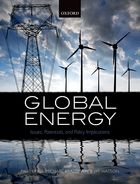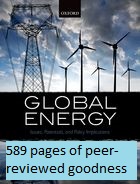Is land area a barrier, or a significant constraint, to achieving 100% renewables?
The question has been floating around for a few years; individual pieces of work had found that the answer globally was no, land area is not a barrier – only a tiny fraction of land would be needed to power the world with 100% renewables. Such global schemes allowed for, even relied upon, international trade of energy. That’s a very reasonable assumption: after all, both developed and developing countries have for many decades relied on international trade for their energy supplies, with several relying on imports for 100% of their energy supplies.
Other work had looked at individual countries: and found very similar results: that only small proportions of land area would be needed for 100% renewables.
Mark Z Jacobson, Mark Delucchi and colleagues have gone one step further, producing a 100% renewable plan for each country in the world for which data is available (that’s 137 countries, representing 92.6% of the projected global 2050 population).
Hover over the dots on the chart to see information on individual countries. Click on a dot to see more about that particular scenario, on the Solutions Project site. Start typing a country’s name in the box above to find a country, then click on the country’s name in the dropdown: the corresponding point on the chart will be identified. Press <Enter>, or click on the point, to open a new tab with more details for the 100% renewables scenario for that country.
Here’s how the projected 2050 global population splits out:
90.7% will be in the 124 countries using less than 5% of their land;
91.2% will be in the 132 countries using less than 20% of their land;
8.4% would be in more than 50 countries without available data currently;
0.4% in 5 countries pending investigation.
Method
The land-use figures here are based on the Delucchi & Jacobson 100% Solutions Project. The figures plotted in the chart above are the most conservative end of their scenarios, using the lower end of the ranges for the capacity factors, and the higher end of the ranges for area per installation. If you hover over a particular point, you’ll see the uncertainty range on the numbers. The figures represent the total land area taken: that is, not just the area for new installations (which is the land-area you see on the 100.org and TheSolutionsProject.org websites), but all installations.
The chart is a log-log plot, as the data spans several orders of magnitude. One side-effect of this is that the point that’s visually halfway between 1 and 10 doesn’t have a value of 5.5, but rather a value just above 3.
Now, inevitably there’s going to be someone who doesn’t like the idea that 100% renewables is not only clean, safe, secure and affordable, but also it wouldn’t take up that much space either. And they’re going to moan that 20% is way too much space to use, and the population would never accept it. The funny thing is, the country at almost 20% land-use for renewables is Switzerland, and there would be very little new space used for 100% renewables: the country already uses almost all that 20% for its existing hydro-electric plant.
So there we go. “country-sized renewables” was a myth all along. Renewables don’t need to be country-sized to make a difference, at all. Almost all countries just need a tiny percentage of their land used, to achieve a 100% renewable energy supply.
Data source
Delucchi, M.A., M.Z. Jacobson, Z.A.F. Bauer, S. Goodman, and W. Chapman, 2015. Spreadsheets for 139-country 100% wind, water, and solar roadmaps. Accessed 14 December 2015

